Karen Lusky
June 2019—The pathologic approach to evaluating specimens as part of a workup for medical lung disease demands a different strategy than is typically used for the patient with a question of neoplasia, says Brandon T. Larsen, MD, PhD, senior associate consultant in the Department of Laboratory Medicine and Pathology at Mayo Clinic Arizona and associate professor, Mayo Clinic School of Medicine. Incorporating clinical and imaging information is essential to arriving at the best diagnosis, he says. “And the pathologist should have a low threshold for consulting with the medical record or getting on the telephone and talking with his or her clinical colleagues.”
Dr. Larsen’s remarks represent some of the recurring themes in a CAP18 session, “Forget Your Unease With Interstitial Lung Disease: Top 10 Pearls to Change Your Practice Immediately,” which he co-presented with Maxwell L. Smith, MD, a consultant in the same department and associate professor, Mayo Clinic School of Medicine. The goal in developing the course, Dr. Smith says, “was to share with the general surgical pathology community the challenges we see that they face most often.” It was also to provide a bit of the background data—clinical and radiographic—in the setting in which pathologists see these biopsies, to better equip them to sidestep the pitfalls.
Dr. Larsen reviewed the current classification of interstitial lung diseases (Fig. 1). “The first category includes the diffuse parenchymal lung diseases where there is a known cause or association that can be demonstrated through clinical, radiologic, and/or laboratory means,” he said. The second category of interstitial or diffuse parenchymal lung diseases includes the idiopathic interstitial pneumonias, which are clinically idiopathic and therefore diagnoses of exclusion by definition. The other categories include the granulomatous lung diseases, such as hypersensitivity pneumonitis and sarcoidosis, and a “wastebasket category” of other diffuse lung diseases.
With interstitial lung disease (ILD), pathologists see patterns of injury in the lung biopsy, Dr. Larsen said. “We don’t actually see specific diagnoses a lot of the time, which is what makes this a challenging arena.” In addition, “biopsies that have identical histology to the idiopathic interstitial pneumonias may actually have very clearly defined etiologies clinically.” For example, a biopsy that looks like a usual interstitial pneumonia, or UIP, pattern isn’t necessarily always idiopathic. “It can certainly be some other problem.”
In discussing their pathologic approach to the lung biopsy in ILD, Dr. Smith shared a poster titled “Leslie’s 6 Patterns of Pulmonary Pathology,” compiled by now-retired Mayo Clinic pathologist Kevin O. Leslie, MD (Fig. 2, and available at www.6patterns.org/the-poster). To explain why the poster is so useful, Dr. Smith showed an image of a scorpion and asked two questions: “Is this good or bad? It’s bad, right? When I put the image up there, you knew it was bad. The hair on the back of your neck is standing up a bit.”
“The second question is, how many legs does this guy have?” It’s a more difficult question, Dr. Smith said, observing that some people weren’t even attempting to answer because they didn’t want to “engage the brain” to consider it. Some were counting until they got to the pedipalps and couldn’t decide if it was a leg or an arm. The scorpion in the image was an Arizona bark scorpion. Of the thousands of scorpion species in the world, “only a few of them are venomous, and this one is one of the ones that is venomous,” he said. “So these are nasty buggers.”
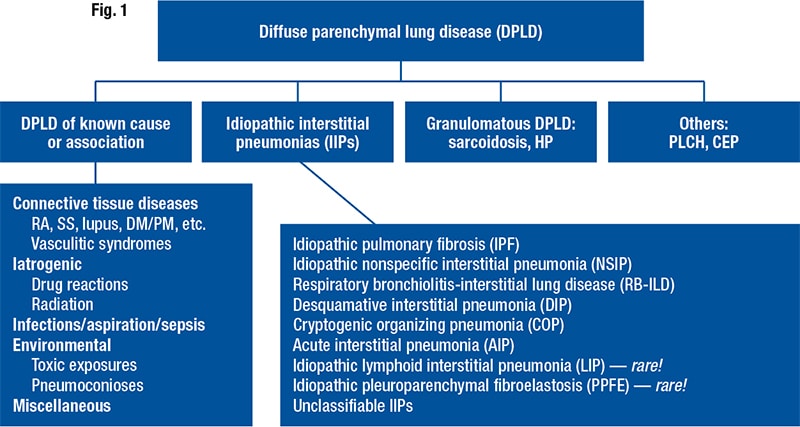
Figure reused with permission by Drs. Smith and Larsen; Content from AJRCCM 2002;165:277–304 and AJRCCM 2013;188:733–748.
Dr. Smith said the exercise embodies two ways people think, according to cognitive scientists: fast and slow. Those attending the session involuntarily answered the first question about whether the scorpion was good or bad. “This is your fast thinking. It happens quickly; it requires no effort. It’s like a tubular adenoma. Super easy.”
Fast thinking provides a survival advantage. “When I’m at my house and stick my foot down next to the scorpion, I jump back really fast,” Dr. Smith illustrated. “I don’t have to stop and think, ‘Well, it has eight legs and has the tail doing this, and I’m going to move my foot.’” However, fast thinking “is prone to bias because sometimes I put my foot down next to a coiled-up rubber band, and I jump back too, and then I look kind of silly.”
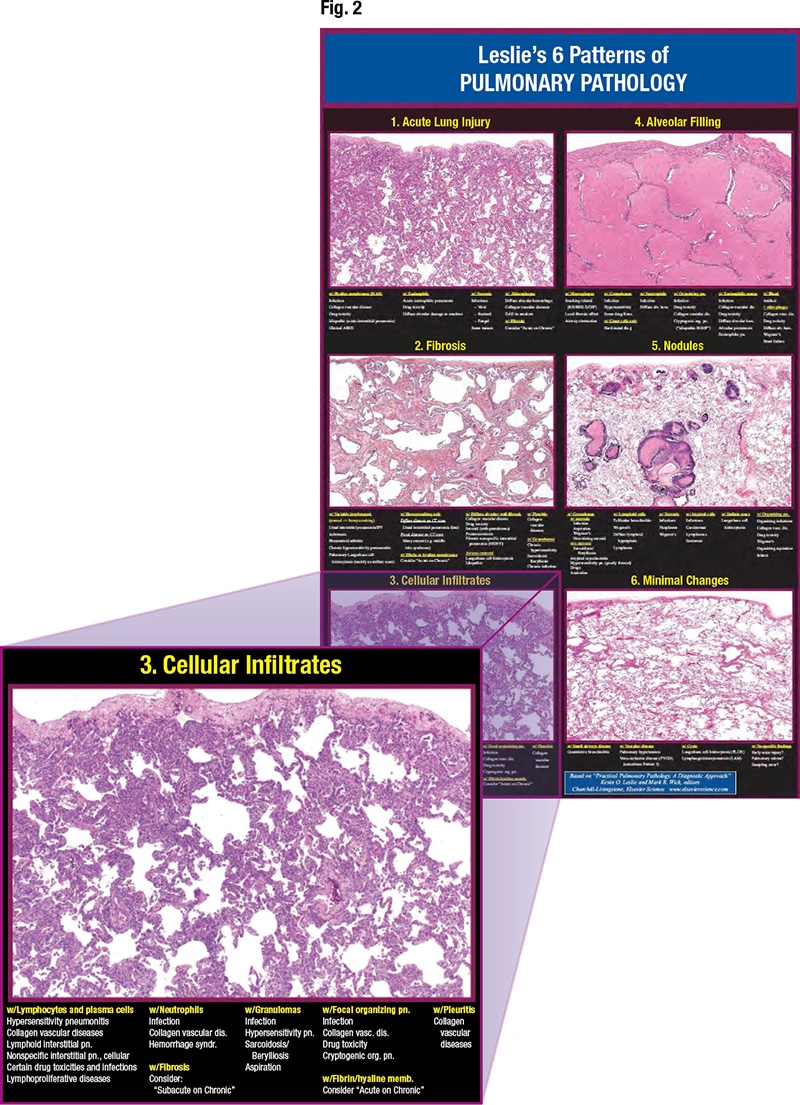 The second question about the number of scorpion legs involves slow thinking. It requires voluntary activation and effort; it’s slow and inefficient. “This is like the polyp you get at three in the afternoon that is not a tubular adenoma or a hyperplastic polyp. And you are like, ‘Ahh, is it an SSA [sessile serrated adenoma]?’” Slow thinking “gives you an intellectual advantage,” Dr. Smith said. “It’s very analytical and calculating.”
The second question about the number of scorpion legs involves slow thinking. It requires voluntary activation and effort; it’s slow and inefficient. “This is like the polyp you get at three in the afternoon that is not a tubular adenoma or a hyperplastic polyp. And you are like, ‘Ahh, is it an SSA [sessile serrated adenoma]?’” Slow thinking “gives you an intellectual advantage,” Dr. Smith said. “It’s very analytical and calculating.”
The six patterns of pulmonary pathology poster offers the benefits of fast and slow thinking. There are only six patterns, Dr. Smith said, which pathologists can easily determine with their fast thinking: “Acute lung injury: edema, hyaline membranes. Fibrosis: scarring. Cellular infiltrates: a lot of lymphoplasmacytic infiltrate. Alveolar filling: You don’t see any more air spaces. Nodules are nodules,” he said. “Everybody can recognize a nodule. And then minimal change. You look at the biopsy and say it looks pretty much normal.” Underneath each fundamental pattern is a list of additional things pathologists should look for to develop a differential diagnosis and dig further into the case.
Fast thinking gets the pathologist the first step, Dr. Larsen said. “The second step, of course, is to slow it down and start looking for clues that can help refine your diagnosis.” In that regard, he recommends also assessing the severity and distribution of disease. “Some injury processes are mild and some are severe, and then there is other stuff in between, and depending on how severe that injury is, the consequence in the biopsy will differ.”
As pathologists know, the pulmonary lobule is the functional unit of the lung, Dr. Larsen said. “There is the bronchovascular bundle in the center of the lobule, and then the airway branches into respiratory alveolar ducts.” The alveoli are in the periphery. As one might expect, he said, a mild injury to the alveolar parenchyma could cause mild thickening or mild scarring of the alveolar parenchyma. Yet the lung’s architecture is still maintained. To show how that might appear histologically, Dr. Larsen referred to the image of mild diffuse fibrosis (Fig. 3), saying, “Most of us would recognize this as an NSIP (nonspecific interstitial pneumonia) type process from a mild inflammatory injury to that alveolar parenchyma.”
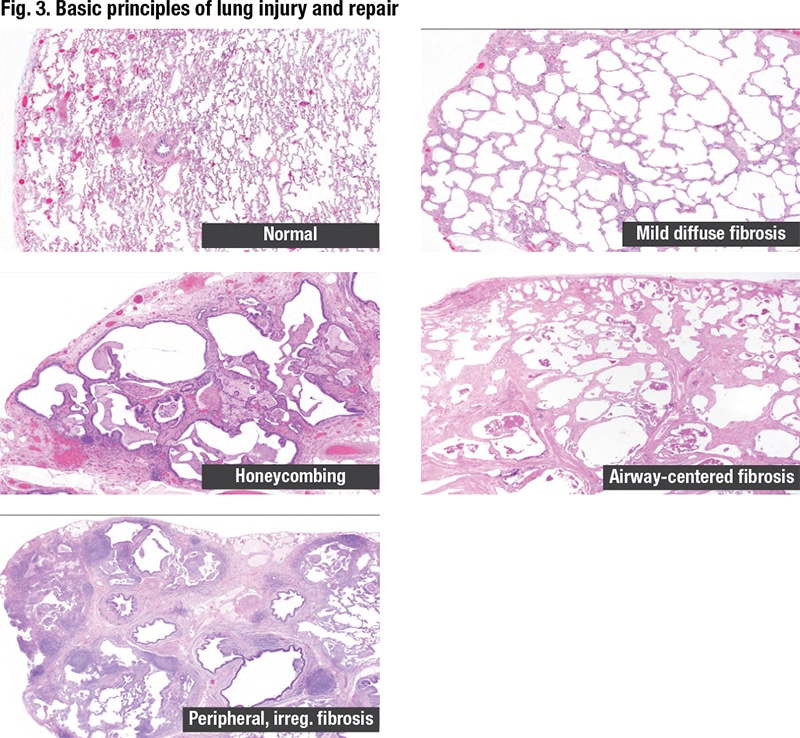 That’s different from a severe injury in which all alveolar structures are destroyed. The body has no framework to repair that damage, other than to lay down a lot of scar tissue. When that scar develops and contracts, it pulls on the airways in the middle of that lobule, making them ectatic, Dr. Larsen said, pointing to the image of honeycombing (Fig. 3). “So it’s essentially a tractional bronchiolectasis in the center of that destroyed lobule that has nothing but a bunch of fibrosis in its periphery,” he said. In lung pathology, this honeycombing is the result of a severe injury process involving that lobule. “You can see the histologic correlate very clearly: cystically dilated air spaces surrounded by scarring.”
That’s different from a severe injury in which all alveolar structures are destroyed. The body has no framework to repair that damage, other than to lay down a lot of scar tissue. When that scar develops and contracts, it pulls on the airways in the middle of that lobule, making them ectatic, Dr. Larsen said, pointing to the image of honeycombing (Fig. 3). “So it’s essentially a tractional bronchiolectasis in the center of that destroyed lobule that has nothing but a bunch of fibrosis in its periphery,” he said. In lung pathology, this honeycombing is the result of a severe injury process involving that lobule. “You can see the histologic correlate very clearly: cystically dilated air spaces surrounded by scarring.”
In terms of the distribution of injury, Dr. Larsen finds it useful to identify an airway-centered pattern of injury. If some type of injurious agent is inhaled into the central airways, such as aspirated food or an antigen to which the person has been sensitized, it will preferentially affect the central part of the lobule. “You will end up with central destruction of the lobule with scar formation,” he said. (Fig. 3). “If that scar occurs and then starts to contract and mature, it will pull on the surrounding parenchyma, and you can end up with cystic dilatation of the peripheral parenchyma in that lobule,” which would look somewhat like the airway-centered fibrosis in the image. “If you see airway-centered fibrosis, you know you are probably dealing with an injury process that involves some sort of substance that is coming in through the airways.”
 Drs. Larsen and Smith presented 10 cases, among them the two reported in this article. They took turns acting as though they were the original pathologist “falling into the pitfall of the case,” Dr. Smith said. The other one would then come in and explain what the pitfall was and how to avoid it.
Drs. Larsen and Smith presented 10 cases, among them the two reported in this article. They took turns acting as though they were the original pathologist “falling into the pitfall of the case,” Dr. Smith said. The other one would then come in and explain what the pitfall was and how to avoid it.
The pulmonologist was astonished: “Normal? My patient is dying, on oxygen, short of breath, with bilateral infiltrates. Please send that case out.”
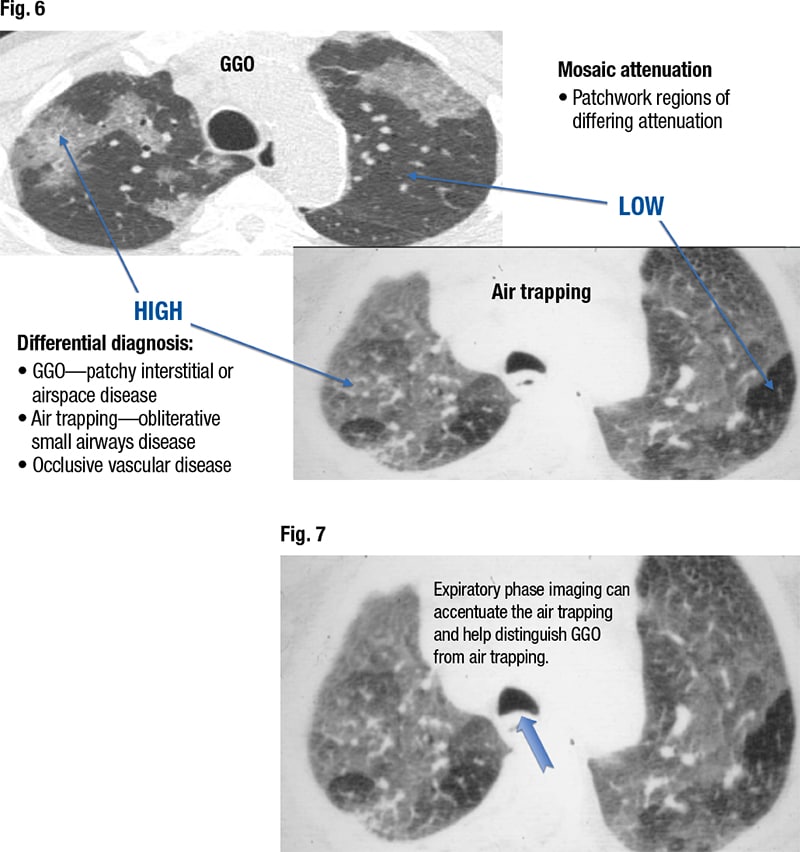 Dr. Larsen pointed out that people who have a surgical wedge biopsy are almost always very ill. And the radiologic differential diagnoses for ground glass opacities are diffuse alveolar damage, acute lung injury, cryptogenic organizing pneumonia, nonspecific interstitial pneumonia, or aspiration. “So there’s clearly a discrepancy between the histopathology and the radiology” and what the pulmonologist suspected. The pathologist seems to be wrong, he said. It’s not a normal biopsy; the patient is very sick.
Dr. Larsen pointed out that people who have a surgical wedge biopsy are almost always very ill. And the radiologic differential diagnoses for ground glass opacities are diffuse alveolar damage, acute lung injury, cryptogenic organizing pneumonia, nonspecific interstitial pneumonia, or aspiration. “So there’s clearly a discrepancy between the histopathology and the radiology” and what the pulmonologist suspected. The pathologist seems to be wrong, he said. It’s not a normal biopsy; the patient is very sick.
The radiologist was responsible for the discrepancy in this case. Dr. Larsen noted that mosaic attenuation is a helpful characteristic on a CT scan, signifying a phenomenon in which the lung demonstrates patchy lighter and darker areas—gray, black, white. Ground glass denotes areas where the lung is lighter in color, and the lung architecture behind that can be seen. “So it’s lighter gray, if you will,” he said. “But the radiologists know that other things can cause this patchwork where, in fact, the light areas are not the abnormality; the dark areas are the abnormality,” which is an indicator of air trapping owing to disease of the small airways (Fig. 6).
“This is a common misinterpretation that we see,” Dr. Larsen continued, because usually the mosaic attenuation is ground glass, and the ground glass opacities are the abnormality. Sometimes, however, the opposite is true and sometimes the radiologist misinterprets this kind of phenomenon. (One of the clues that radiologists use to distinguish GGOs from air trapping is “the expiratory phase or expiratory imaging,” Dr. Larsen said. If those abnormalities become more prominent when the person exhales, the radiologist interprets that as indicative of air trapping. [Fig. 7].)
Dr. Larsen said he’d already shared the differential diagnosis for GGOs. “But, basically, when it’s really ground glass opacities, the clinician is expecting acute injury, diffuse alveolar damage—some sort of acute process—whereas air trapping will typically manifest itself histologically as a minimal change biopsy.” (Fig. 8)
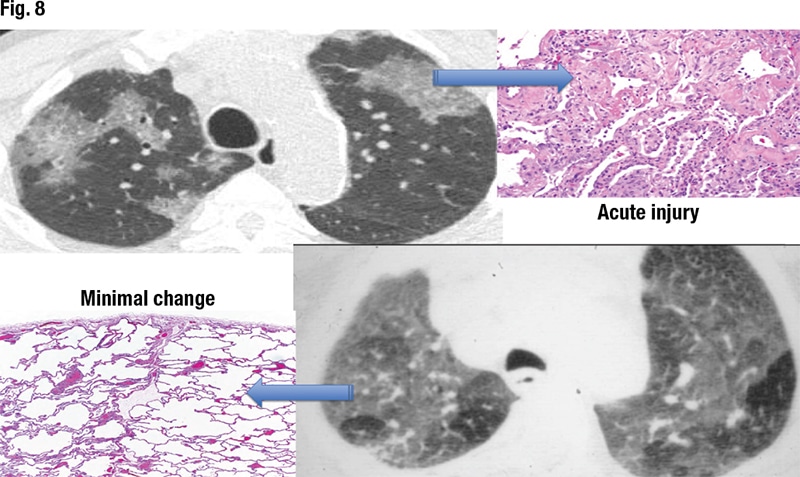 The pearl: When pathologists see a minimal change biopsy, they should consider small airways disease, constrictive bronchiolitis, chronic vascular disease, “or something along those lines,” Dr. Larsen advises. “In our particular case, if you go back to this biopsy, it does look essentially normal and yet something is missing from this histology. Where are the airways? The small airways have been pruned as part of that disease process. They are fewer in number. The disease process has resulted in destruction of the small airway, which is why they end up with a bunch of air trapping.”
The pearl: When pathologists see a minimal change biopsy, they should consider small airways disease, constrictive bronchiolitis, chronic vascular disease, “or something along those lines,” Dr. Larsen advises. “In our particular case, if you go back to this biopsy, it does look essentially normal and yet something is missing from this histology. Where are the airways? The small airways have been pruned as part of that disease process. They are fewer in number. The disease process has resulted in destruction of the small airway, which is why they end up with a bunch of air trapping.”
 CAP TODAY Pathology/Laboratory Medicine/Laboratory Management
CAP TODAY Pathology/Laboratory Medicine/Laboratory Management
